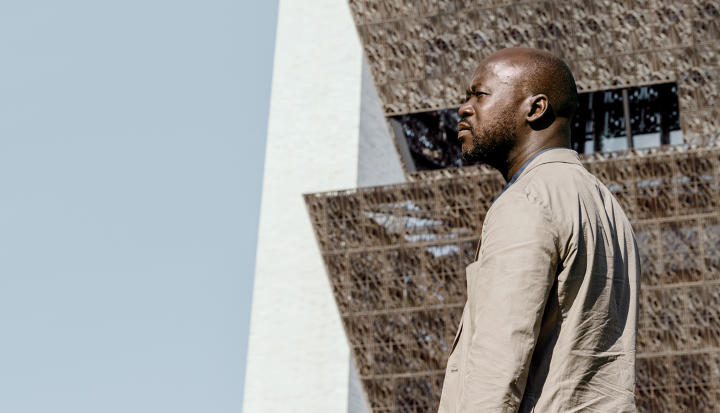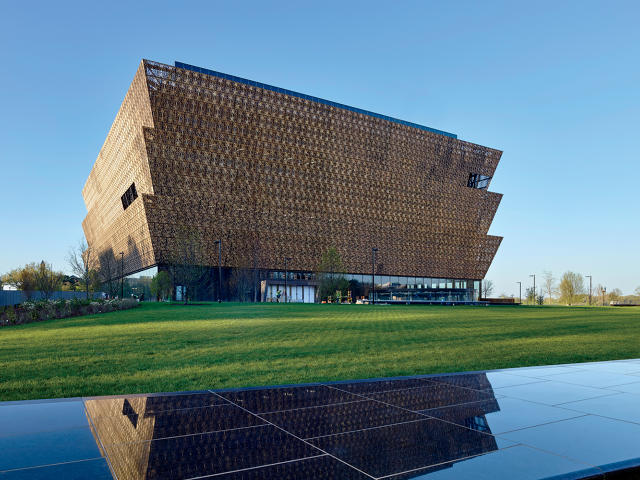

For its first 72 years as the nation’s capital, Washington, D.C., was a slave territory, and the five-acre tract on which the new National Museum of African American History and Culture sits once contained a slave market. So even before the ribbon was cut or the foundation laid, the building, which opens September 24, was already firmly rooted in the geography of America’s most inhumane and violent institution.
Yet instead of sadness, David Adjaye, the museum’s lead designer, saw celebration. He knew all about slavery, segregation, and lynchings, as well as more current reminders of that shameful legacy, such as the killings of Trayvon Martin and other innocent black men, women, and children. But Adjaye wanted to capture a broader view. “I refused to see the African-American story as tragic,” says the Tanzanian-born, British-raised architect. “Instead, it is an extraordinary journey of overcoming, and shaping, what America is.”
That idea was a touchstone of the building’s design; the $540 million, 400,000-square-foot structure is literally encased in the symbols of African-American triumph. From the visually striking exterior to the carefully designed exhibit-hall environments, Adjaye and his team—in collaboration with architecture firms the Freelon Group, Davis Brody Bond, and SmithGroupJJR—have created what he calls “a spatial narrative,” by which he means that the building itself tells the story of the African-American experience.
Located on the National Mall near the Washington Monument, Adjaye’s metallic, multitiered structure consists of three inverted box shapes that thrust upward. Inspired by Yoruban caryatids—traditional wooden sculptures of female figures found in East Africa that are often topped by box-shaped crowns—the design is meant to recall both the head wraps worn by many black women in the U.S. and hands raised in praise or prayer, a common symbol in African-American spiritual life. “I was fascinated with how these [shapes] were connected,” says the much-lauded architect, who has constructed prominent buildings such as the Nobel Peace Centre in Oslo. “It was so uncanny to make connections between the Yoruba caryatid and modern expressions in black America. They became clues to the architecture of the building.” The lattice exterior, which is made out of 3,600 bronze-colored cast-aluminum panels, references ironwork patterns created by 19th-century enslaved workers in New Orleans and Charleston, South Carolina—an homage to the skill and the unpaid labor of these craftsmen.

Established in 2003 by an act of Congress, the museum is being overseen by founding director Lonnie Bunch III, a longtime Smithsonian executive. Adjaye, whose group beat out hundreds of other firms for the commission, was named lead designer in 2009, and construction started three years later. While the building was in progress, Bunch and his team—in consultation with historians and luminaries such as Oprah Winfrey and Colin Powell—amassed around 34,000 artifacts, mostly from private collectors. Ideally, the curators want to create dialogue and “complicate questions of race, agency, and history,” says deputy director Kinshasha Holman Conwill. “The hope is that people will leave here transformed and wanting to learn more.”
That seems likely. During a preopening tour in June, when the interior was still essentially a construction site, the space exuded a solemn dignity. Workers wearing hard hats were guiding cloth-covered display items into various exhibition spaces, and the partially completed rooms were full of shipping crates and dangling wires. But things were far enough along to offer a sense of what the experience will be like. The overarching idea is that a visitor’s journey through the museum mirrors the rise of African-American people’s position in society. Exhibits begin three levels underground, where low ceilings and a lack of natural light create a somewhat claustrophobic effect. That heightens the emotional impact of galleries such as Slavery & Freedom, which displays a 16.5-foot cotton tower, artifacts from a wrecked slave ship, and two log cabins, including one that housed enslaved people on Edisto Island, South Carolina. As you move upward, rooms feature a lace shawl owned by Harriet Tubman, Emmett Till’s coffin, a plane flown by Tuskegee Airmen, and the original Soul Train sign. The exhibit halls are much more than just expertly curated trips through time: They resonate because America has still not decisively resolved the complex issues that make the museum so necessary in the first place.
One of the most powerful moments comes about halfway through, when museumgoers arrive at a room called the Contemplative Court. This is the point where underground galleries give way to aboveground halls with high ceilings and picture windows, where the museum focuses on more-optimistic topics such as sports, music, visual arts, hair, and style. The Contemplative Court’s sunlit stone benches and soothing water feature offer a space “to reframe what you experienced and contextualize it,” says Adjaye, who hopes visitors will sit for a few minutes and reflect on the nation-shaping hardships they’ve just seen. “Then you move on up into the light.”
[Source:-Co design Blog]





